Brown flycatcher may refer to:
- Southern shrikebill, a species of flycatcher found in New Caledonia and Vanuatu
- Asian brown flycatcher, a species of flycatcher found in southern and eastern Asia, and Indonesia
Brown flycatcher may refer to:

The spotted flycatcher is a small passerine bird in the Old World flycatcher family. It breeds in most of Europe and in the Palearctic to Siberia, and is migratory, wintering in Africa and south western Asia. It is declining in parts of its range.
Pied flycatcher may refer to:

The red-breasted flycatcher is a small passerine bird in the Old World flycatcher family. It breeds in eastern Europe and across Central Asia and is migratory, wintering in south Asia. It is a regular passage migrant in western Europe, whereas the collared flycatcher which breeds further east is rare. This is because of the different migration direction.

The Siberian blue robin is a small passerine bird that was formerly classified as a member of the thrush family, Turdidae, but is now more generally considered to belong to the Old World flycatcher family, Muscicapidae. It and similar small European species are often called chats. Recent research suggests that this species and some other East Asian members of Luscinia should be classified in a new genus, together with the Japanese and Ryūkyū robins. The genus name Larvivora comes from the new Latin larva meaning caterpillar and -vorus meaning eating, and cyane is Latin for "dark-blue".

The Asian brown flycatcher is a small passerine bird in the flycatcher family Muscicapidae. The word Muscicapa comes from the Latin musca, a fly and capere, to catch. The specific dauurica refers to Dauria, an area of south-eastern Siberia named after a local nomadic tribe.

The African paradise flycatcher is a medium-sized passerine bird. The two central tail feathers of the male are extended into streamers that commonly are more than twice as long as the body. The female tail feathers are of moderate length and without streamers. The upper parts of the male body, wings, and tail are boldly coloured in chestnut or rusty shades, but the underparts and the head are variably grey to blue-gray, with the head of the mature male being darker, commonly glossy black with greenish highlights. The beak and other bare areas, including a wattle ring round the eye, match the colour of the surrounding feathers. The female coloration is similar, though not so showy and glossy and with the head paler.

The red-bellied paradise flycatcher, also known as the black-headed paradise flycatcher, is a medium-sized passerine bird of the family of monarch flycatchers. It is native to intra-tropical forests of Africa. The male bird is about 17 cm (7 in) long and has a black head, a mainly chestnut body, and a tail with streamers nearly twice as long as the body. The colouring is somewhat variable across the bird's range. Both females and juveniles lack the tail streamers and are a duller brown colour. It is closely related to the African paradise flycatcher, and the two can hybridise.
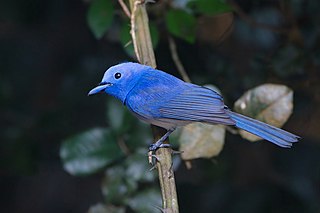
The black-naped monarch or black-naped blue flycatcher is a slim and agile passerine bird belonging to the family of monarch flycatchers found in southern and south-eastern Asia. They are sexually dimorphic, with the male having a distinctive black patch on the back of the head and a narrow black half collar ("necklace"), while the female is duller with olive brown wings and lacking the black markings on the head. They have a call that is similar to that of the Asian paradise flycatcher, and in tropical forest habitats, pairs may join mixed-species foraging flocks. Populations differ slightly in plumage colour and sizes.
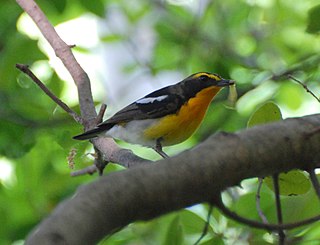
The narcissus flycatcher is a passerine bird in the Old World flycatcher family. It is native to the East Palearctic, from Sakhalin to the north, through Japan across through Korea, mainland China, and Taiwan, wintering in southeast Asia, including the Philippines, Vietnam and Borneo. It is highly migratory, and has been found as a vagrant from Australia in the south to Alaska in the north.

The brown-breasted flycatcher or Layard's flycatcher is a small passerine bird in the flycatcher family Muscicapidae. The species breeds in north eastern India, central and Southern China and northern Burma and Thailand, and migrates to southern India and Sri Lanka. It forages for insects below the forest canopy, often close to the forest floor.
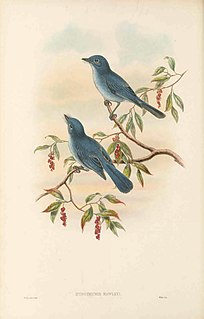
The cerulean paradise flycatcher is a medium-sized, blue flycatcher with bright cerulean blue plumage, a bare white orbital ring, dark brown iris, bluish black bill and pale blue-grey below. The young has a shorter tail and grey underparts. It is the only member of the monotypic genus Eutrichomyias.
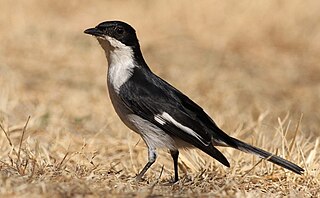
The fiscal flycatcher is a small passerine bird in the Old World flycatcher family. It is a resident breeder in Botswana, South Africa, Lesotho, Mozambique and Swaziland, and a vagrant to Namibia.

The Japanese paradise flycatcher, also called the black paradise flycatcher, is a medium-sized passerine bird native to southeastern Asia. It is a glossy black, chestnut and white bird, slightly smaller than either the Amur paradise flycatcher or Blyth's paradise flycatcher, but similar in appearance. Males have exceptionally long tails. Females are generally duller in appearance and have shorter tails.

The dark-sided flycatcher is a small passerine bird belonging to the genus Muscicapa in the Old World flycatcher family Muscicapidae. It has a wide breeding distribution in the East Palearctic with northern birds migrating south for the winter. It is also known as the Siberian flycatcher or sooty flycatcher, the latter name is also used for the sooty flycatcher of Africa.
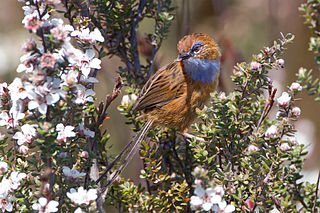
The southern emu-wren is a species of bird in the Australasian wren family, Maluridae. It is endemic to Australia. Its natural habitats are temperate forests and Mediterranean-type shrubby vegetation.
The brown-streaked flycatcher is a species of bird in the family Muscicapidae. It is found in southern Myanmar, southern Thailand, northern peninsular Malaysia, and northeast Borneo. Some authorities consider it to be a subspecies of the Asian brown flycatcher. In 2020, a possible vagrant was sighted 300 km (190 mi) south of the Australian town of Broome. This vagrant was later confirmed after poo samples were collected and tested against DNA of this species.
S. frontalis may refer to:
The purple swamphen has been split into the following species:
In 2015, the Asian paradise flycatcher was split into the following three species: